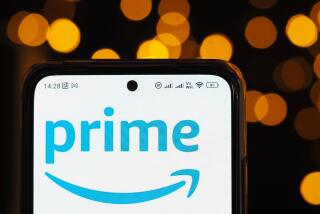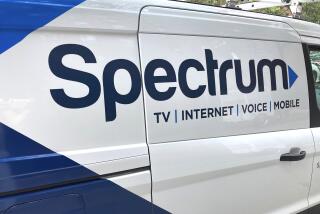Say Goodbye to Some Cheap Wireless Time
WASHINGTON — The era of free-anytime minutes may be waning. In its place, wireless carriers envision a network of more-versatile mobile phones that offer more lucrative services such as high-speed connections to news, shopping, games and e-mail.
After a decade of brutal price wars slashed the cost of wireless dialing by two-thirds, carriers are reducing their cheapest calling hours to boost profits and make room for new services.
The move comes as competition in the wireless industry eases and service providers try to nudge consumers away from nomadic bargain hunting and toward making mobile phones a more integral part of life.
To that end, carriers are cutting back discounting during heavily used early evening hours and spending billions of dollars to introduce faster wireless Internet access and other services they believe will discourage customers from constantly switching between calling plans.
Because many carriers offer free phones and low introductory rates, it can take six to 18 months before a wireless company makes money off a new customer. Despite all the extra services available with many wireless contracts, price is still the deciding factor for most consumers. The annual customer turnover rate for the wireless industry averages 25% to 30%.
Even so, “carriers are betting that if there is a decent value proposition, and more advanced services, consumers will stay put,” said Jane Zeiwig, a wireless phone analyst who heads the consulting firm Herschel Associates in Bethesda, Md.
The three carriers that have adjusted their calling plans this year--Verizon Wireless, Cingular Wireless and Sprint PCS--are moving gingerly. In most cases, off-peak dialing plans will be trimmed by only one hour, starting at 8 or 9 p.m. instead of as early as 7 p.m. previously. And the changes cover only new customers. Current customers are not affected by the cutbacks unless they modify their contracts.
Wireless access to the Internet is not a new idea. All the major carriers offer wireless e-mail or Web access. But most existing wireless phones retrieve such data at only 14.4 kilobits per second, one-fourth the speed of most home computer modems.
To make wireless Internet attractive, it has to be faster. Wireless executives say their networks often are overtaxed during the early morning and evening hours, when subscribers are on the move and scrambling to take advantage of less costly off-peak dialing hours. The adjustments in off-peak dialing hours are aimed at better managing the voice traffic during these heavily used hours to make way for more data services.
At the same time, several companies--including AT&T; Wireless, Sprint PCS, Nextel Communications Inc. and Verizon Wireless--are investing billions in network upgrades to offer higher-speed wireless Internet access.
Verizon and Nextel--the nation’s No. 2 and No. 5 wireless carriers, respectively--are separately building networks that, by summer, will offer wireless Internet access at speeds of 40 kbps to 60 kbps. Similarly, Sprint, which already has more than 2 million wireless data users, is spending $700 million to introduce in June a new wireless technology that will have speeds of up to 144 kbps.
Hoping Faster Web Access Holds Subscribers
Executives say the higher speeds will allow quicker Web browsing and will jump-start new revenue sources, such as video games on wireless phones, text-messaging services and mobile e-commerce.
“Data services will be an increasingly important component of the wireless industry, and our network was built with data services in mind,” Sprint Chairman William T. Esrey declared this month during an investment meeting at the company’s Overland Park, Kan., headquarters.
Verizon spokesman Jeffrey Nelson said: “We’re finding that people that use these [Internet] applications are much more” loyal customers. “When customers ... add data services--whether wireless games or business applications--they are much more likely to stay on as satisfied customers.”
The new strategy is a departure from the discounting and aggressive marketing campaigns that characterized the industry over the last decade.
With most major wireless markets boasting five or six competitors, mobile phone companies offered big discounts and enlisted Hollywood stars such as Jamie Lee Curtis, Paul Reiser and Candice Bergen to market service.
Hard Sell Boosts
Customer Base
The hard sell succeeded in one way: Today there are more than 128 million wireless customers. They’ve been drawn by phone rates that the Federal Communications Commission says have fallen from 58 cents a minute in 1993 to 21 cents in 2000.
But profits have proved elusive amid the price cutting.
In October, Nextel, the fifth-largest U.S. wireless phone carrier, reported a third-quarter loss of $209 million. And this month Esrey predicted that, although Sprint PCS revenue is expected to grow more than 50% in 2001 to as much as $9.8 billion, the unit is likely to have an operating loss of $600 million for the year.
But the outlook may change in the wake of recent federal deregulation of the wireless industry.
In November, for instance, the FCC agreed to gradually increase --and eventually eliminate--a federal limit on the amount of airwaves a wireless phone company can own.
In addition, the threat of a seventh national wireless carrier entering the market significantly diminished this fall after executives of NextWave Telecom Inc. decided to forgo their controversial bid for $16 billion worth of wireless licenses.
A settlement between NextWave and the federal government remains up in the air. But most experts said NextWave is unlikely to launch nationwide wireless service anytime soon.
Some analysts, including Knox Bricken, a wireless expert at Yankee Group in Boston, doubt whether the trimming of off-peak hours and the addition of new wireless services will immediately improve the bottom line for wireless companies.
A recent Yankee Group survey, for instance, concluded that price is still the No. 1 factor for consumers choosing a wireless service. And Zeiwig of Herschel Associates said consumers also appear more influenced by the design and features of cell phone handsets than fancy wireless data services.
Even some of those who frequently use their mobile phones to access the Internet say the industry must improve basic services before consumers will make a bigger commitment to mobile phones.
“At 9 a.m. your cell phone says you have no messages, but at 1 p.m., it then says you got two messages at 8 a.m.,” said Matt Coffin, who uses his cell phone to get data from his LowerMyBills.com business, a Santa Monica-based Web site that helps people comparison shop for credit cards, cell phones and other services.






